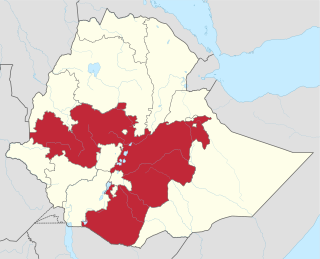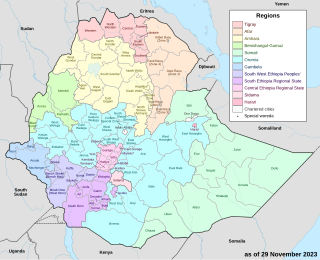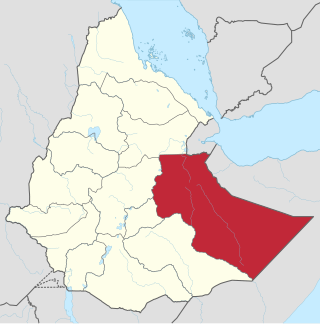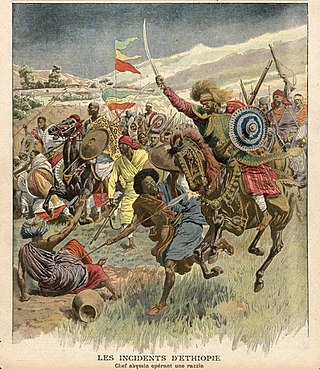
Oromia is a regional state in Ethiopia and the homeland of the Oromo people. The capital of Oromia is Addis Ababa (Finfinne).

Shewa, formerly romanized as Shua, Shoa, Showa, Shuwa, is a historical region of Ethiopia which was formerly an autonomous kingdom within the Ethiopian Empire. The modern Ethiopian capital Addis Ababa is located at its center.

Arsi is a zone in Oromia Region of Ethiopia, named after a clan of the Oromo, who inhabit in the area.

Hararghe was a province of eastern Ethiopia with its capital in Harar.

Asella is a town in central Ethiopia. Located in the Arsi Zone of the Oromia Region 126 km (78 mi) south from Addis Ababa, this town has a latitude and longitude of 7°57′N39°7′E, with an elevation of 2,430 meters. Asella hosts an Asella Airport. Asalla was the capital of Arsi Province until that province was demoted to a Zone of Oromia with the adoption of the 1995 Constitution. It retains some administrative functions as the seat of the present Arsi Zone.

North Shewa is a zone in the Amhara Region of Ethiopia. North Shewa takes its name from the kingdom and former province of Shewa. The Zone is bordered on the south and the west by the Oromia Region, on the north by South Wollo, on the northeast by the Oromia Zone, and on the east by the Afar Region. The highest point in the Zone is Mount Abuye Meda, which is found in the Gish woreda; other prominent peaks include Mount Megezez. Towns in North Shewa include Ankober, Debre Birhan, and Shewa Robit.

Bale Zone is a zone in Oromia Region of Ethiopia. Bale is bordered on the south by the Ganale Dorya River which separates it from Guji Zone, on the west by the West Arsi Zone, on the north by Arsi Zone, on the northeast by the Shebelle River which separates it from West Hararghe Zone and East Hararghe Zone, and on the east by the Somali Region.
Bekoji was a woreda in Oromia Region, Ethiopia. Part of the Arsi Zone, Bekoji was bordered on the south by Gedeb, on the southwest by Kofele, on the west by Munesa, on the north by Digeluna Tijo, on the east by Sherka, and on the southeast by the Shebelle River which separated it from the Bale Zone. The administrative center of this woreda was Bekoji; other towns included Lemu Sirba, Meraro, Siltana and Sirbo. Bekoji was divided for Enkelo Wabe and Limuna Bilbilo woredas.
Fentale is one of the districts in the Oromia of Ethiopia. Part of the East Shewa Zone located in the Great Rift Valley, Fentale is bordered on the southeast by the Arsi Zone, on the southwest by Boset, on the northwest by the Amhara Region, and on the northeast by the Afar Region. The administrative center of Fentale is Metehara; other towns include Haroo Adii.
Dodota is one of the woredas in the Oromia Region of Ethiopia. Part of the Arsi Zone it is located in the Great Rift Valley. It is part of the former Dodotana Sire woreda, which was divided for Dodota and Sire woredas. Dodotana Sire is bordered on the south by Tena, on the southwest by Hitosa, on the north by the Misraq Shewa Zone, on the east by Jeju, and on the southeast by Sude. The administrative center for the woreda is Dera; other towns include Awash Melkasa.
Hitosa is one of the Aanaas in the Oromia Regional State of Ethiopia. Aanaa of Lude Hitosa was separated from Hitosa. Part of the Arsi Zone, Hitosa is bordered on the south by Digeluna Tijo, on the southwest by Tiyo, on the west by Batu Dugda, on the northwest by the East Shewa Zone, on the northeast by Dodotana Sire, and on the east by Tena. The administrative center of the woreda is Iteya; other towns include Borujawi and Ligaba.
Sherka is one of the Aanaas in the Oromia Regional State of Ethiopia. Research by Ulrich Braukämper uncovered a local tradition that traced the origins of this woreda's name to an ancient Ethiopian province, Sharkha, which vanished as a political unit in the 16th century. Part of the Arsi Zone, Sirkaa is bordered on the south by the Shebelle River which separates it from the Bale Zone, on the southwest by Bekoji, on the west by Digeluna Tijo, on the north by Tena, and on the east by Robe. Gobesa is the administrative center; other towns include Gaadoo Gunaa.
Dera is a town in southeastern Ethiopia. Located in the Arsi Zone of the Oromia Region, this town has a latitude and longitude of 08°20′N39°19′E. It is the administrative center of Dodotana Sire woreda.
Digelu is a town in central Ethiopia. Located in the Arsi Zone of the Oromia Region to the east of Sagure, it has a latitude and longitude of 7°45′N39°15′E with an elevation of 2,713 meters (8,901 ft). It is one of three settlements in Digeluna Tijo woreda.

Arsi Oromo is an ethnic Oromo branch, inhabiting the Arsi, West Arsi and Bale Zones of the Oromia Region of Ethiopia, as well as in the Adami Tullu and Jido Kombolcha woreda of East Shewa Zone.The Arsi are made up of the Sikkoo-Mandoo branch of Barento Oromo. The Arsi in all zones speaks Oromo share the same culture, traditions and identity with other subgroup Oromo.
The Sultanate of Arababni was a small Muslim sultanate located in what is now the Arsi Zone of Ethiopia. Founded around the 12th century, it was the smallest and weakest of the Muslim kingdoms described by the Muslim geographers al-Umari and al-Makrizi.
Chercher sometimes spelled as Charchar was a former province in Hararghe now part of Oromia. Also known as Ahmar and West Hararghe, chercher is the name given mainly to the eastern escarpment highland areas of Oromia state's West Hararaghe Zone, where the chains of Checher or Ahmar mountains rise and extend inland from the Great Rift Valley in its northwest. The capital of the former Chercher province was Chiro.
The Battle of Azule was fought on 6 September 1886, between the forces of Ras Darge Sahle Selassie of Shewa and a force of Arsi Oromo. It was part of a broader series of expansion campaigns done under Menelik II, Negus of Shewa, referred to by some historians as the Agar Maqnat. The battle of Azule was important as it represents the crushing of a large Arsi army by one under Menelik; it also demonstrates the dynamic of gun-wielding Shewans fighting Spear-wielding Arsi that many historians like to stress when discussing Menelik's expansions; it also retains symbolic and historic importance in the politics and identities of many.

Menelik's Invasions, also known as the Agar Maqnat were a series of wars and conquests carried out by Menelik II of Shewa to expand the Ethiopian Empire.

Anti-Oromo sentiment or Oromophobia, is opposition, hatred, discrimination or prejudice against the Oromo ethnic group. Anti-Oromo sentiment has root its accusations during the rule of Ethiopian Empire, particularly in the reign of Emperor Menelik II in 1880s. Oromo nationalists argued that the Oromo have been subjugated and oppressed by dominant Amhara feudal rulers and its oppression persisted throughout 20th century. Under Haile Selassie, Oromos have been targeted to persecutions after long wave of resistance. Many Oromo revolutionaries like Mamo Mazamir, Haile Mariam Gamada and General Tadesse Birru faced execution by Selassie government and then the Derg regimes.








